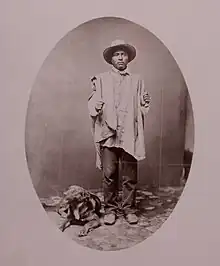Manuel Incra Mamani
Manuel Incra Mamani was a Bolivian Incan cascarillero (bark and seed hunter) who found a cinchona tree that had a higher proportion of quinine than most others.[1] It went into commercial cultivation, providing most of the world's quinine.

Life and work
Mamani was an experienced bark and seed collector, and had worked for Charles Ledger since 1843.[2] He was able to identify 29 different sorts of cinchona trees.[3]
Mamani waited through four years of unsuitable weather (frosts destroyed the seeds from the high-quinine plants), and gave offerings to mountain spirits, in order to obtain a sample of seed from the high-quinine cinchona in 1865.[2][4][5] The seeds that Mamani provided were sent to Ledger's brother, George, who then sold them to the Dutch government, who then cultivated plants in Java.[6]
The plant that Mamani collected seed from was later named Cinchona ledgeriana. He is noted only as a "native" in some accounts of its finding and cultivation.[7]
Local people disapproved of Mamani helping Ledger.[8]
Death
In 1871, whilst on a seed-collecting trip, Mamani was arrested, imprisoned and beaten.[9] Some have suggested that this was likely because of his providing seeds to foreigners.[3][8] Others suggest it was because he refused to identify his employer.[10] He subsequently died of his injuries.[8]
References
- Baird, J. Kevin (2004-04-01). "The Miraculous Fever Tree: Malaria and the Quest for a Cure That Changed the World". The American Journal of Tropical Medicine and Hygiene. 70 (4): 457–458. doi:10.4269/ajtmh.2004.70.457.
- Holland, J. H. (1932). "Ledger Bark and Red Bark". Bulletin of Miscellaneous Information (Royal Botanic Gardens, Kew). 1932 (1): 1–17. doi:10.2307/4107725. ISSN 0366-4457. JSTOR 4107725.
- Bland, John (1988). "He gave quinine to the world" (PDF). World Health – via World Health Organisation.
- Canales, Nataly Allasi (7 April 2022). "Hunting lost plants in botanical collections". Wellcome Collection. Retrieved 2022-05-09.
- Honigsbaum, Mark (2005). The Fever Trail: In Search of the Cure for Malaria. Macmillan. ISBN 978-0-312-42180-9.
- "Drinkable bark that lost its touch". Times Higher Education (THE). 2002-01-18. Retrieved 2022-05-09.
- Zhu, Lihua (2018-06-27). "Products of the Empire: Cinchona: a short history". www.lib.cam.ac.uk. Retrieved 2022-05-09.
- "The weird and wonderful world of the plant hunters - part 4: Quinine, the cinchona tree and empires in competition". Trees for Cities. 2 April 2020. Retrieved 2022-05-09.
- Chatterjee, Sria (11 March 2021). "The Long Shadow Of Colonial Science". Noema.
- Lee, M.R. (2002). "Plants Against Malaria, Part 1: Cinchona or the Peruvian Bark" (PDF). J R Coll Physicians Edinb. 32 (3): 189–196. PMID 12434796.